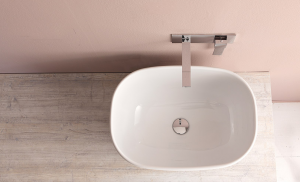In addition to the well-established ceramic, new cutting-edge materials combining natural components with synthetic ones have emerged in the market of bathroom fixtures production.
Cristalplant and Tecnoril are two of the main of the so-called Solid Surfaces: their characteristics make them highly used in the designing of state of the art sinks and bathtubs.
That’s the same for Mineralmarmo, which include materials such as Mitek, Mak and Geacryl: all of them are highly resistant, and they only differ in their appearances and in their finishings.
The doubt people are mostly likely to have when it comes to pick new bathroom fixtures is a simple one: good, old ceramics, or components made out of one of the new materials?
Here’s an overview of the above-cited materials, which will outline their properties and hopefully help in choosing the one meeting each one’s needs.
Ductility, resistance and elegance
Both Mineralmarmo and Solid Surface have deeply transformed the market of bathroom furnishing, as they quickly gained the first place as the most preferred materials in the creation of trendy and appealing fixtures.
What we obtain from the mixture of minerals and acrylics resins is Mak, a material that is 100% bacteria-free, resistant and unalterable. Due to its special covering films, it can be given the most diverse finishings: it is available in mat, satin and silky finish – a perfect example of the latter is Tondo sink by Mastella Design – in glossy finish (Lux) as in Maxi Vov sink, or in Stone finish, with a stone effect.
Another leading material in bathroom fixtures production is Mitek: it is a kind of Mineralmarmo whose composition is 75% natural minerals, and resin polyester for the remainders.
It has high resistance as a plus, as its original beauty lasts through the years and makes it the perfect choice for public spaces. An excellent example of a wise use of this material is Marte Due countertop washbasin by Mastella Design.
Talking about Solid Surfaces, Cristalplant comes from a mixture of quartz, granite and acrylic which is then given a variety of shapes with the cast moulding technique, a low-pressure kind of moulding. This means it is an extremely ductile material: there are no design limits when it comes to shapes and dimensions and it also allows cutting and gluing, which enables further customization of the components made out of this solid surface. Its perfectly velvety looks like natural stone, with the chance to have it varnished in SofTouch paint on all the parts that have no contact with water once manufacturing is done. Furthermore, it is 100% recyclable, hypoallergenic and nontoxic, fireproof and revivable, which means it only takes some soap and a scarping sponge to take it back to its original beauty.
A perfect example of Cristalplant USE in bathroom fixtures are the elegant sinks by Mastella Design: Kon, the unique freestanding sink and Kalla, moulded from a single block of this extremely malleable material in a wavy shape.
Another Solid Surface allowing for the creation of extremely elegant fixtures is Tecnoril. Made out of a mixture of minerals and high-quality acrylic resins, it enables the creation of compact, non-porous, durable surfaces which can be easily revived when needed. The sophisticate look of the fixtures produced with this material can be observed in the unmistakable design of sinks such as Tam.
Ceramics, Engineered stone and Solid Surfaces: a comparison
Ceramics, Engineered stone and Solid Surfaces have some common features: they’re all scratch, hit, stain and heath resistant, they’re highly hygienic and easy to clean and they don’t require any specific maintenance.
Ceramics have enormously benefitted from the evolution of manufacturing techniques, and now it can be molded in ways that would have been unthinkable of just a few years ago: it is now possible to choose the color, the texture, the thickness, and it’s also possible to combine it with other materials. Its great resistance, combined with the evolution ceramics industry has had lately, enabled for this material to be used even outside the household realm: is not unusual to see this material used in street furniture, such as in underground’s flooring and upholstery and in several other public infrastructures.
As for its use in bath sinks specifically, progresses in manufacturing techniques have given ceramics a further advantage as for resistance: ceramics now used in bathroom fixtures are highly valuable, 100% waterproof, translucent and highly resistant to the acids that might be contained in cleaning products.
A good example of the evolution in ceramics aesthetic is West sink by Mastella .
Moreover, Mastella is currently working on bringing a new guise of its old ceramics back in its catalogue by designing a collection of ceramics bottom-mount sinks.
Compared with ceramics, Solid Surfaces and Engineered stone have three not to be underestimated advantages. Their malleability, a feature that is now extending to ceramics as well, has been already quoted: in this case, Cristalplant is unrivalled, as it is moulded with thermoformed moulds which allows manufacturers to give the material any desired shape. On the other hand ceramics are still manufactured with readymade matrixes, which somewhat limits modelling.
In addition to that, Cristalplant and Tecnoril in particular can be revived: in the case the surface breaks it can be easily fixed with a completely invisible soldering, and in the case of stubborn stains they can quickly be removed with some abrasive paste or extra fine sandpaper.
Last but not least, Solid Surface superficies are less cold to the tact than ceramics ones, winning on the confort side as well.





